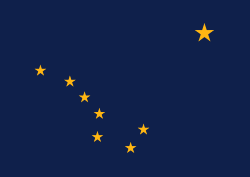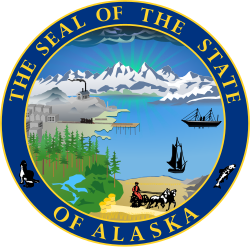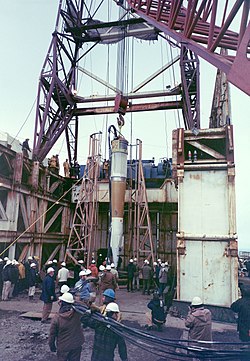Portal:Alaska
 Introduction   Alaska (/əˈlæskə/ ⓘ ə-LASS-kə) is a non-contiguous U.S. state on the northwest extremity of North America. Part of the Western United States region, it is one of the two non-contiguous U.S. states, alongside Hawaii. Alaska is also considered to be the northernmost, westernmost, and easternmost (the Aleutian Islands cross the 180th meridian into the eastern hemisphere) state in the United States. It borders the Canadian territory of Yukon and the province of British Columbia to the east. It shares a western maritime border, in the Bering Strait, with Russia's Chukotka Autonomous Okrug. The Chukchi and Beaufort Seas of the Arctic Ocean lie to the north, and the Pacific Ocean lies to the south. Technically, it is a semi-exclave of the U.S., and is the largest exclave in the world. Alaska is the largest U.S. state by area, comprising more total area than the following three largest states of Texas, California, and Montana combined, and is the seventh-largest subnational division in the world. It is the third-least populous and most sparsely populated U.S. state; however, with a population of 740,133 as of 2024, it is the most populous territory in North America located mostly north of the 60th parallel, with more than quadruple the combined populations of Northern Canada and Greenland. The state contains the four largest cities in the United States by area, including the state capital of Juneau. The state's most populous city is Anchorage, and approximately half of Alaska's residents live within its metropolitan area. Indigenous people have lived in Alaska for thousands of years, and it is widely believed that the region served as the entry point for the initial settlement of North America by way of the Bering land bridge. The Russian Empire was the first to actively colonize the area beginning in the 18th century, eventually establishing Russian America, which spanned most of the current state and promoted and maintained a native Alaskan Creole population. The expense and logistical difficulty of maintaining this distant possession prompted its sale to the U.S. in 1867 for US$7.2 million (equivalent to $162 million in 2024). The area went through several administrative changes before becoming organized as a territory on May 11, 1912. It was admitted as the 49th state of the U.S. on January 3, 1959. Abundant natural resources have enabled Alaska— with one of the smallest state economies—to have one of the highest per capita incomes, with commercial fishing, and the extraction of natural gas and oil, dominating Alaska's economy. U.S. Armed Forces bases and tourism also contribute to the economy; more than half of the state is federally-owned land containing national forests, national parks, and wildlife refuges. It is among the most irreligious states and one of the first to legalize recreational marijuana. The Indigenous population of Alaska is proportionally the second highest of any U.S. state, at over 15 percent, after only Hawaii. (Full article...) Entries here consist of Good and Featured articles, which meet a core set of high editorial standards.
 The Akutan Zero, also known as Koga's Zero (古賀のゼロ) and the Aleutian Zero, was a Mitsubishi A6M2 Model 21 Zero Japanese fighter aircraft piloted by Petty Officer Tadayoshi Koga, that crash-landed on Akutan Island, Alaska Territory, during World War II. It was found intact by the Americans in July 1942 and became the first Zero acquired by the United States during the war that could be restored to airworthy condition. It was repaired and flown by American test pilots. As a result of information gained from these tests, American tacticians were able to devise ways to defeat the Zero, which was the Imperial Japanese Navy's primary fighter plane throughout the war. The Akutan Zero has been described as "a prize almost beyond value to the United States", and "probably one of the greatest prizes of the Pacific War". Japanese historian and JASDF lieutenant general Masatake Okumiya stated that the acquisition of the Akutan Zero "was no less serious" than the Japanese defeat at the Battle of Midway, and that it "did much to hasten Japan's final defeat". Nonetheless, historian John Lundstrom and others challenge "the contention that it took dissection of Koga's Zero to create tactics that beat the fabled airplane". The Akutan Zero was destroyed in a training accident in 1945. Parts of it are preserved in several museums in the United States. (Full article...) TopicsCategoriesSelected article -Anchorage, officially the Municipality of Anchorage, is the most populous city in the U.S. state of Alaska. With a population of 291,247 at the 2020 census, it contains nearly 40 percent of the state's population. The Anchorage metropolitan area, which includes Anchorage and the neighboring Matanuska-Susitna Borough, had a population of 398,328 in 2020, accounting for more than half the state's population. At 1,706 sq mi (4,420 km2) of land area, the city is the fourth-largest by area in the U.S. Anchorage is in Southcentral Alaska, at the terminus of the Cook Inlet, on a peninsula formed by the Knik Arm to the north and the Turnagain Arm to the south. First settled as a tent city near the mouth of Ship Creek in 1915 when construction on the Alaska Railroad began, Anchorage was incorporated as a city in November 1920. In September 1975, the City of Anchorage merged with the Greater Anchorage Area Borough, creating the Municipality of Anchorage. The municipal city limits span 1,961.1 sq mi (5,079.2 km2), encompassing the urban core, a joint military base, several outlying communities, and almost all of Chugach State Park. Because of this, less than 10 percent of the Municipality (or Muni) is populated, with the highest concentration of people in the 100 square-mile area that makes up the city proper, on a promontory at the headwaters of the inlet, commonly called Anchorage, the City of Anchorage, or the Anchorage Bowl. Due to its location, almost equidistant from New York City, Tokyo, and Murmansk, Russia (straight over the North Pole), Anchorage lies within 10 hours by air of nearly 90 percent of the inhabited global north. For this reason, Ted Stevens Anchorage International Airport is a common refueling stop for international cargo flights and home to a major FedEx hub, which the company calls a "critical part" of its global network of services. (Full article...) Selected picture - Fairbanks and the Alaska Range at midday during the winter solstice, looking south from the hills above Farmers Loop Road. Photo credit: User: Joe n bloe General imagesThe following are images from various Alaska-related articles on Wikipedia.
Recognized content
Featured articlesGood articles
Featured pictures
Former featured pictures
Related Portals
Related WikiProjectsState facts
State symbols:
Tasks
Associated WikimediaThe following Wikimedia Foundation sister projects provide more on this subject:
Discover Wikipedia using portals |































































